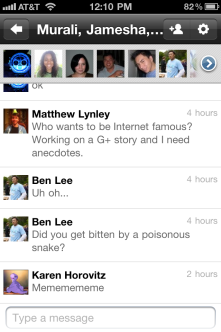
The search giant’s social network — which delivers data in bite-sized chunks thanks to the use of Circles — is built for early adopters somewhere between 21 and 27. Facebook has become a glorified phone book, while Google+ is the place where we go to communicate with friends. I can’t speak for everyone else, but more than half of my Facebook friends have already completed said migration.
[aditude-amp id="flyingcarpet" targeting='{"env":"staging","page_type":"article","post_id":308171,"post_type":"story","post_chan":"none","tags":null,"ai":false,"category":"none","all_categories":"business,social,","session":"D"}']On Facebook, you typically run into the problem of over-sharing. There’s no filter on the regular News Feed, so you have to basically parse through every single story until you find something of interest. The Top News feed is a little better about this because it picks up on heavily-commented stories or stories from profiles you actively follow, but there’s still an enormous amount of content. We’ve become really efficient at finding relevant information through both systems, but it’s still a broken way of doing so.
On Google+, curation happens at both ends — the person posting and the person reading — through the site’s Circles feature. Instead of having a single friends list, Google+ makes its users divvy contacts up into smaller lists of friends. You can then pick which circles to specifically view content, or view all circles at once.
AI Weekly
The must-read newsletter for AI and Big Data industry written by Khari Johnson, Kyle Wiggers, and Seth Colaner.
Included with VentureBeat Insider and VentureBeat VIP memberships.
On the other end, I know that many of my friends have their own “Baseball” circles, to which they post content related to Baseball. I know that when I select my “friends” stream, I’m going to receive content from those posting in “Baseball” circles (or, in the case of one friend, the “infamous Beisbol” circle.)
My own circles include specific circles for PR officials that are trying to stalk me to better refine their pitches. There’s a circle for the competition — which includes the likes of MG Siegler of TechCrunch and Ben Parr of Mashable. I have my own circle for friends with beards — only epic ones, which should be obvious by the name: “AAAAAAWWWWW BEEEEAAAARD.” I have a circle for my family, too, though for some reason it felt oddly appropriate to add former VentureBeat executive editor Owen Thomas to that circle.
VentureBeat’s Jolie O’Dell, who joined the team yesterday, remains unconvinced by Google+. Her argument is that it doesn’t appeal to the middle ground, and circles are too complex. It’s true that Facebook has simplicity going for it, but that simplicity also carries a cost with savvy individuals who know how to use a network as well as they know how to ride a bike.
[aditude-amp id="medium1" targeting='{"env":"staging","page_type":"article","post_id":308171,"post_type":"story","post_chan":"none","tags":null,"ai":false,"category":"none","all_categories":"business,social,","session":"D"}']
That group of Google+ loving misfits are early adopters who generate more content in an hour than most people do in several days. It’s also a group that has to deal with over-sharing on sites like Twitter and Facebook, both of which tried to tackle the issue. Facebook tried pushing Lists and Groups, but those didn’t work easily enough for most people. Twitter expects you to curate the people you follow and also lets you add people to “lists,” but Twitter’s public nature means isn’t a very good tool for following what’s going on with your close circle of friends.
Google+ already has more than 10 million user and 20 million visitors, which it picked up in 16 days. Twitter and Facebook both took around two years before they hit 20 million users. Those sites didn’t have billions of dollars in revenue and some of the best engineering talent around when they launched, but that shouldn’t take away from Google’s accomplishment with Google+.
VentureBeat's mission is to be a digital town square for technical decision-makers to gain knowledge about transformative enterprise technology and transact. Learn More